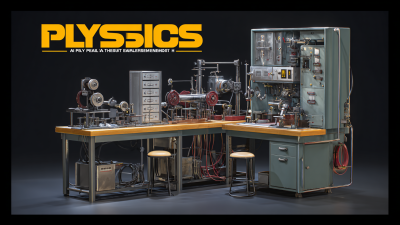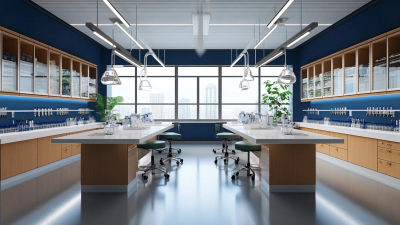In any scientific research environment, a Lab Bench serves as the cornerstone of productivity and organization. This essential piece of laboratory furniture is more than just a workspace; it facilitates a plethora of activities ranging from experimental setups to data collection and analysis.
 A well-designed Lab Bench can greatly enhance efficiency by providing ample space for instruments, reagents, and samples, while also promoting a safe and structured workflow. Furthermore, investing in a high-quality Lab Bench tailored to the specific needs of your laboratory not only supports various research endeavors but also maintains a conducive environment for innovation and collaboration.
Whether you are setting up a new lab or optimizing an existing one, understanding the importance of a Lab Bench is crucial to achieving scientific excellence.
A well-designed Lab Bench can greatly enhance efficiency by providing ample space for instruments, reagents, and samples, while also promoting a safe and structured workflow. Furthermore, investing in a high-quality Lab Bench tailored to the specific needs of your laboratory not only supports various research endeavors but also maintains a conducive environment for innovation and collaboration.
Whether you are setting up a new lab or optimizing an existing one, understanding the importance of a Lab Bench is crucial to achieving scientific excellence.
A lab bench serves as a fundamental fixture in any laboratory, providing a designated workspace for scientists and researchers to conduct experiments and analyses safely. According to a report by Grand View Research, the global laboratory furniture market is projected to reach $6.7 billion by 2025, highlighting the increased investment in essential lab infrastructure. A well-designed lab bench contributes not only to organization but also enhances productivity, allowing researchers to focus on their work without unnecessary distractions.
The purpose of a lab bench goes beyond merely being a countertop; it is engineered to support various laboratory needs such as chemical resistance, stability for weighty instruments, and compliance with safety regulations. The American National Standards Institute (ANSI) emphasizes the importance of ergonomics in workstation design, ensuring that lab benches facilitate a comfortable and efficient workflow. Consequently, equipping a laboratory with appropriate lab benches significantly contributes to the overall efficiency of research operations, fostering an environment that promotes innovation and discovery.
| Dimension | Description |
|---|---|
| Material | Typically constructed from durable surfaces such as epoxy resin, laminate, or stainless steel, resistant to chemicals and easy to clean. |
| Size | Common sizes range from 4 to 8 feet in length, depending on the available space and intended use within the lab. |
| Weight Capacity | Designed to support varying weights, with certain models capable of holding several hundred pounds to accommodate heavy lab equipment. |
| Features | May include built-in storage, adjustable height options, power outlets, sinks, and specialized cutouts for equipment. |
| Purpose | Provides a stable and organized working surface for conducting experiments, assembling equipment, and performing analysis. |
A lab bench is an essential piece of furniture in any laboratory, designed to facilitate various scientific tasks. Key features of a functional lab bench include a durable work surface, often made from materials like laminate or epoxy resin, which resist stains, chemicals, and heat. This ensures that researchers can conduct experiments without concern for damaging the bench. Additionally, the bench should provide ample space for equipment and samples, promoting an organized and efficient workflow.

Another critical component is built-in storage solutions, such as drawers or cabinets, which help keep the workspace tidy and accessible. Some lab benches come equipped with integrated sink stations and gas lines, further enhancing their functionality. Adequate electrical outlets are vital for powering laboratory equipment, while adjustable height features can accommodate the varying needs of personnel. By incorporating these elements, a lab bench not only supports the intricate tasks carried out in a laboratory but also enhances safety and productivity.
 Lab benches are a fundamental component of any laboratory setting, providing a dedicated workspace for scientific research and experimentation. The importance of these surfaces cannot be overstated, as they serve as the backbone for various scientific activities. A well-designed lab bench is crucial for maintaining organization, ensuring that researchers have a clean and efficient area to conduct their experiments. The layout of the bench can significantly affect the workflow, allowing for easy access to essential tools, instruments, and materials, which ultimately enhances productivity.
Lab benches are a fundamental component of any laboratory setting, providing a dedicated workspace for scientific research and experimentation. The importance of these surfaces cannot be overstated, as they serve as the backbone for various scientific activities. A well-designed lab bench is crucial for maintaining organization, ensuring that researchers have a clean and efficient area to conduct their experiments. The layout of the bench can significantly affect the workflow, allowing for easy access to essential tools, instruments, and materials, which ultimately enhances productivity.
Moreover, lab benches are designed to withstand the rigors of scientific work. They are often constructed from durable, chemical-resistant materials that can endure spills and stains, safeguarding the integrity of the research process. This resilience is vital in experiments involving hazardous substances, where safety is paramount. Additionally, specialized lab benches may include features such as built-in sinks, storage cabinets, and adjustable heights, facilitating a customized workspace that meets the specific needs of different scientific disciplines. Overall, investing in quality lab benches is not just about convenience; it is essential for fostering innovation and ensuring safe, efficient research practices.
Laboratories require specialized lab benches tailored to their diverse needs, as the efficiency and safety of scientific work often depend on the choice of furniture. Different environments, from clinical testing to advanced research and development, demand unique designs in lab benches. For instance, with the rise of diagnostic and antibody testing in response to COVID-19, laboratories focusing on high-throughput testing need benches that allow for streamlined workflows and easy access to equipment.
Moreover, the evolution of laboratory design has introduced flexible modular furniture that can adapt to the changing dynamics of research. Custom-fit solutions are now available, allowing labs to optimize their space according to specific workflows and the requirements of experiments, which can significantly enhance productivity. Data from recent industry reports suggest a trend towards integrating advanced technologies and customizable features in lab furniture, underlining the importance of ergonomic designs that adapt to both wet and dry lab settings to accommodate diverse scientific processes.
Additionally, as AI and advanced computational methods revolutionize drug discovery, the design and layout of lab benches must also evolve. Configurations that facilitate collaboration and accommodate digital tools are becoming essential, mirroring the shift towards dry lab environments where traditional equipment may be replaced with digital solutions. This highlights the critical role that modern lab benches play in fostering innovation and efficiency in contemporary research settings.
Maintaining and organizing your lab bench is crucial for ensuring efficiency, safety, and accuracy in laboratory operations. According to the Laboratory Safety Institute, improper organization can lead to accidents, which account for nearly 45% of lab incidents. To mitigate these risks, effective practices include decluttering surfaces and keeping essential tools within arm's reach. Regularly scheduled cleanings can help eliminate hazardous materials, ultimately fostering a safer workplace.
Utilizing storage solutions such as labeled bins and shelving not only optimizes space but also enhances productivity. Research from the National Institute of Standards and Technology indicates that a well-organized lab can boost operational efficiency by up to 30%. Implementing color-coded systems for tools and reagents not only promotes a tidy environment but also aids in quick retrieval of materials, saving valuable time during experiments. By prioritizing a structured and maintained lab bench, laboratories can significantly improve their workflow and ensure that safety protocols are adhered to meticulously.






